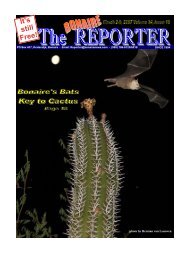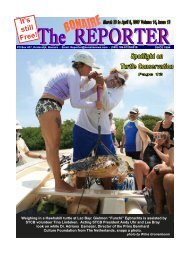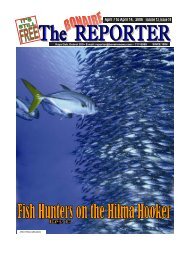July 29 to August 5, 2005 Volume 12, Issue 29 - The Bonaire Reporter
July 29 to August 5, 2005 Volume 12, Issue 29 - The Bonaire Reporter
July 29 to August 5, 2005 Volume 12, Issue 29 - The Bonaire Reporter
Create successful ePaper yourself
Turn your PDF publications into a flip-book with our unique Google optimized e-Paper software.
P<br />
irates are as much a threat <strong>to</strong>day<br />
as in colonial times. Maritime<br />
claims for loss of property and life are<br />
commonplace events. In the days of<br />
empire building, disenchanted seamen<br />
turned pirates were simply opportunists<br />
taking advantage of the chaotic atmosphere<br />
of world order. Others, the so<br />
called “legitimate agents” representing<br />
and appointed by the appropriate king,<br />
were roaming the high seas searching<br />
for likely prey. Some were given<br />
“Charters” and “Land Claims” for new<br />
found terri<strong>to</strong>ries and even elevated <strong>to</strong><br />
positions as governors <strong>to</strong> administer<br />
justice in the newly established colonies<br />
of the “Motherland.” <strong>The</strong> same authorities<br />
that claimed the right <strong>to</strong> bring law,<br />
order and religion <strong>to</strong> these new terri<strong>to</strong>ries<br />
and their inhabitants sanctioned the<br />
lawless and ruthless behavior of these<br />
cutthroat pirates.<br />
A common ploy used by pirate captains<br />
<strong>to</strong> accomplish their task was <strong>to</strong><br />
hoist and display a friendly flag <strong>to</strong> lure<br />
the unsuspecting ship closer for the capture.<br />
It was just like fishing. <strong>The</strong> ship’s<br />
mast was the fishing pole and the flag<br />
was the bait. If the target ship (the prey)<br />
slowed or s<strong>to</strong>pped <strong>to</strong> inspect the flag<br />
(the bait) or allowed the pirate ship (the<br />
fisherman) <strong>to</strong> get within striking distance,<br />
the ambush was completed.<br />
Ambush under the sea<br />
Beneath the sea there are numerous<br />
“pirate fish” hiding in ambush waiting<br />
for an opportunity <strong>to</strong> capture their next<br />
Page 10<br />
meal. <strong>The</strong>y have adopted many different<br />
techniques and developed specialized<br />
biological features <strong>to</strong> satisfy their<br />
daily need for nourishment. We’re diving<br />
the leeward side of the <strong>Bonaire</strong>, the<br />
sea is calm, and it is possible <strong>to</strong> enter<br />
the water anywhere from the shore road<br />
<strong>to</strong> explore the shallow protected reef<br />
that rims this side of the island. This<br />
easy access and gently sloping underwater<br />
reef structure makes it possible<br />
for free diving snorkelers <strong>to</strong> also experience<br />
the hunting behavior of these<br />
flesh- eating piscivores. Let’s explore<br />
<strong>to</strong>gether!<br />
As we approach the <strong>to</strong>p of the reef<br />
crest, at a depth of 15 feet ( 4.5 meters),<br />
we can see one of the most common<br />
“ambush preda<strong>to</strong>rs” hiding within the<br />
gently swaying branches of a Giant Sea<br />
Rod. <strong>The</strong> long slender body of this<br />
adult Trumpet fish is poised in a vertical<br />
posture, moving in rhythm with the<br />
soft coral branches. Its head is pointing<br />
down <strong>to</strong>ward a swirling mass of small<br />
silver fish at the base of the thick stalks.<br />
It will strike with lightning speed, rocketing<br />
forward and simultaneously engulfing<br />
one or several targets with its<br />
specialized hinged jaws.<br />
Safe diving with a purpose and plan<br />
Fish watching requires patience and<br />
concentration. Under the sea, with everything<br />
in perpetual motion, it is difficult<br />
for most visiting divers <strong>to</strong> remain<br />
motionless for more than a few moments.<br />
During these observation excur-<br />
sions, my diving partners seldom remain<br />
at my side and some have even<br />
fabricated elaborate excuses <strong>to</strong> avoid<br />
another “boring” return visit. On this<br />
day, my enthusiastic partner is on her<br />
own mission of discovery. We have devised<br />
a safe dive plan and effective<br />
search pattern <strong>to</strong> satisfy both our needs.<br />
I will start my search with a coral head<br />
at the center of a 10 foot (3 m) wide<br />
circle. My partner, needing more terrain<br />
<strong>to</strong> roam, will keep me in sight and<br />
search in an increasingly larger circle<br />
around me. When we find something of<br />
interest we will use our tank bangers <strong>to</strong><br />
alert each other. It seems <strong>to</strong> be a perfect<br />
marriage of science, safety and simplicity.<br />
Searching for the master of deception<br />
Within minutes of deploying <strong>to</strong> our<br />
positions I hear the rapid metallic<br />
clanging of my partner’s signal device.<br />
I glance in her direction, and she performs<br />
a fantastic display of underwater<br />
gyrations only possible in a weightless<br />
environment. I reach her side as she<br />
points <strong>to</strong>ward a large formation of algae-covered<br />
tube sponges. At first the<br />
sponges appear <strong>to</strong> be dead and almost<br />
colorless. <strong>The</strong> tubes are of various sizes<br />
and have a slightly pinkish hue. I fail <strong>to</strong><br />
see the source of the ecstatic nature of<br />
her pleasure. She looks at me in disbelief<br />
and moves closer <strong>to</strong> point at two<br />
lumps of discolored sponges at the base<br />
of the formation. In that instant I recognize<br />
the unmistakable sight of two pair<br />
of eyes within the lumpy forms. She has<br />
Frogfish<br />
discovered a pair of creatures that have<br />
developed one of the most elaborate<br />
forms of feeding in the sea, a male and<br />
female Longlure Frogfish. Let’s examine<br />
them <strong>to</strong>gether.<br />
We are watching two Frogfishes that<br />
are some of the most sought after fish<br />
on the reef by interested divers and<br />
swimmers when snorkeling. It is said<br />
that <strong>Bonaire</strong> has one of the largest frogfish<br />
populations in the Caribbean. <strong>The</strong><br />
trouble is finding them. Here’s why.<br />
Frogfishes have tiny, cold looking,<br />
black eyes just above and behind their<br />
huge mouth. <strong>The</strong> fish are multi-colored,<br />
short, fat, lumpy, globular and grotesque<br />
eating machines with rough,<br />
Continued on page 11<br />
thick, flesh-like skin, formed by modified<br />
scales, covering their body,<br />
rounded dorsal, anal and tail fins. Frogfishes<br />
also have the ability <strong>to</strong> change<br />
their overall pattern and coloration,<br />
within a short time, <strong>to</strong> perfectly match<br />
their surrounding environment. While<br />
lurking on a colony of sponges, one of<br />
its favorite ambush perches, it will develop<br />
numerous, round, ocellated* body<br />
markings with black centers, surrounded<br />
by various shaded colors <strong>to</strong><br />
resemble the out-current siphons of the<br />
sponges. Today, the smaller male fish<br />
seems more interested in attending the<br />
larger female with her swollen lower<br />
mid-section, than eating. I’ll get back <strong>to</strong><br />
that later.<br />
(Continued on page 11)<br />
<strong>Bonaire</strong> <strong>Reporter</strong> - <strong>July</strong> <strong>29</strong> <strong>to</strong> <strong>August</strong> 5, <strong>2005</strong>
















